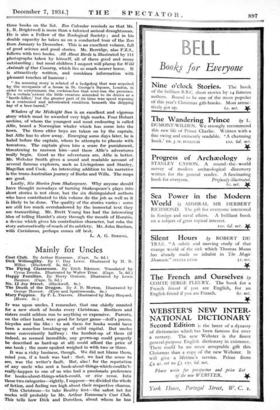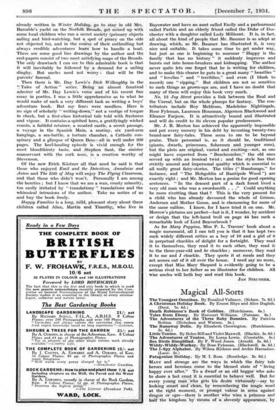Mainly for Uncles
Coot Club. By Arthur Ransome. (Cape. 7e. Od.) The Flying Classroom. By Erich Hastner. Translated by Cyrus Brooks. Illustrated by Walter Trier. (Cape. 7s. 6c1.) Happy Families. By Harry Graham. Illustrated by Lewis Mary Poppins. By P. L. Travers. Illustrated by Mary Shepard. (Howe. Os.) IT was upon uncles, I remember, that one chiefly counted for a new stock of books every Christmas. Brothers and
sisters could seldom run to anything so expensive. Parents,
on the other hand, were good for larger game=doll's prams, bicycles and the like : to ask them for books would have been a senseless breaking-up of solid capital. But uncles came conveniently halfway : the hardest-up of them (if
indeed, as seemed incredible, any grown-up could properly be described as hard-up at all) could afford the price of one book ; the more opulent weighed in with two or three. It was a.risky business, though. We did not blame them, mind you, if a book was bad : that, we had the sense to see, was the writer's fault. But, alas ! for the reputation of any uncle who sent a book-about-things-which-couldn't-
really-happen to one of us who had a passionate preference for books-about-things-which-could, or vice versa. Into
those two categories—rightly, I suppose—we divided the whole of fiction, and feeling ran high about their respective charms. This Christmas—to take Reality first—the safest bet for
uncles will probably be Mr. Arthur Ransome's Coot Club. This tells how Dick and Dorothea, about whom he has already written in Winter Holiday, go to stay in old Mrs. Barrable's yacht on the Norfolk Broads, get -mixed up with some local children who run a secret society (primary objects sailing and bird-watching, but a spot of piracy on the side not objected to), and in the course of their enthralling but always credible adventures learn how to handle a boat. There are some good line drawings by the author and the end-papers consist of two most satisfying maps of the Broads. The only drawback I can see to this admirable book is that it will inevitably be followed by a demand for a sailing dinghy. But uncles need not worry : that will be the parents' funeral.
Then there is Mr. Day Lewis's Dick Willoughby in the " Tales of Action " Series: ' Being an almost fanatical admirer of Mr. Day Lewis's verse and of his recent fine essay in poetics, I was a little apprehensive as to what he would make of such a very different task as writing a boys' adventure book. But my fears were needless. Here is no sign of scholarly " writing-down," not a vestige of tongue in cheek, but a first-class historical tale told with freshness and vigour. It contains a spirited hero, a gratifyingly wicked cousin, a faithful retainer, a moated castle, a secret passage, a voyage in the Spanish Main, a mutiny, six yard-arm hangings, a sea-battle, a torture chamber, a Catholic con- spiracy and a glimpse of Queen Bess--all in well under 200 pages. The keel-hauling episode is vivid enough for the most bloodthirsty taste, and Stephen Sant, the sinister manservant with the cork nose, is a creation worthy of Stevenson. -
Of the new Erich Ktistner all that need be said is that those who enjoyed Emil and the Detectives, Annaluise and Anton and The 35th of May will enjoy The Flying Classroom, and that those who didn't won't. Personally I am among the heretics ; but I know that we are a wan, crusty minority, too easily irritated by " translationy " translations and the whimsical intrusions of the author. Take no notice of us and buy the book freely.
Happy Families is a long, mild, pleasant story about three children called Alice, Martin and Timothy, who live in Bayswater and have an aunt called Emily and a parlourmaid called Parkin and an elderly friend called the Duke of Dor- chester with a daughter called Lady Millicent. It is, in fact, all about the kind of people that Mr. Baumer is so adept at drawing, which, as Mr. Baumer has illustrated it, is very nice and suitable. It takes some time to get under way, but just as one is beginning to murmur " Happy is the family that has no history " it suddenly improves and bursts out into house-breakers and kidnapping. The author never quite lets one forget that he is - writing for children, and to make this clearer he puts in a great many " beastlies " and " lovelies " and " terriblies," and even (I blush to record) one " ripping." But children are not so sensitive to such things as grown-ups are, and I have no doubt that many of them will enjoy this book very much.
No. 12 Joy Street provides a link between the Real and the Unreal, but on the whole plumps for fantasy. The con- tributors include Roy Meldrum, Madeleine Nightingale, Rose Fyleman, Laurence Housman, Algernon Blackwood and Eleanor Farjeon. It is attractively bound and illustrated and will do credit to its eleven popular predecessors.
Mr. J. B. Morton has achieved the apparently impossible and put every nursery in his debt by inventing twenty-two brand-new fairy-tales. These seem to me to be beyond praise. Their personnel is, as it should be, traditional (giants, dwarfs, princesses, fishermen and younger sons), but the plots are original, varied and exciting—not, as one might have expected from " Beachcoinber," the old ones served up with an ironical twist ; and the style has that strictly amoral and impersonal quality which is essential to all really great fairy-stories. The titles (" Rumbungo," for instance, and " The Hobgoblin of Rantipole Wood ") are exactly right ; and Mr. Morton has a genius for good opening sentences. " In the densest part of a dark forest lived a very old man who was a swordsmith . . ." Could anything be more rivetting than that ? This is the very present for a child who has already devoured the whole of Grimm, Andersen and Mother Goose, and is clamouring for more of the same calibre. I know, for I have tried it on one. Mr. Morrow's pictures are perfect—but is it, I wonder, by accident or design that the left-hand troll on page 44 has such a remarkable look of Lord Beaverbrook ?
As for Mary Poppins, Miss P. L. Travers' book about a magic nursemaid, all I can tell you is that it has kept two such widely different critics as a boy of 10 and a girl of 6 in perpetual chuckles of delight for a fortnight. They read it to themselves, they read it to each other, they read it to the three-year-old and he chuckles ; moreover, they read it to me and .1 chuckle. They quote it at meals and they act scenes out of it all over the house. I need say no more, except that Miss Mary Shepard is evidently going to be a serious rival to her father as an illustrator for children. All wise uncles will both buy and read this book.
JAN STRLITHER.



















































 Previous page
Previous page